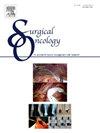Comparison between bipolar scissors, monopolar electrocautery, and hydrodissection in nipple-sparing mastectomy
IF 2.4
4区 医学
Q3 ONCOLOGY
引用次数: 0
Abstract
Background
The common techniques used in nipple-sparing mastectomy (NSM) are hydrodissection (tumescent dissection) and electrocautery. We hypothesized that bipolar scissors (diathermy scissors) would improve surgical outcomes in mastectomy.
Methods
We prospectively compared 50 patients undergoing NSM using the bipolar scissor technique to retrospective data from patients who had previously undergone NSM with hydrodissection (n = 50) or electrocautery (n = 50). Operation time, intraoperative bleeding, drainage per day, duration till drain removal, and serious complications were compared.
Results
Operation time was significantly better with the bipolar scissors (34.1 ± 4.9 min) and hydrodissection (36.2 ± 6.6 min) compared to monopolar electrocautery (53.7 ± 4.8 min) (p < 0.001). Intraoperative bleeding was significantly less with the bipolar scissors (123.4 ± 27.7 ml) and hydrodissection (126.6 ± 25.1 ml) compared to electrocautery (161.8 ± 25.0 ml) (p < 0.001). Additionally, the drainage per day and the duration till drain removal was 79.7 ± 18.3 ml for 3.22 ± 0.79 days and 92.4 ± 41.3 ml for 3.58 ± 1.23 days for the bipolar scissors and hydrodissection techniques respectively were significantly better compared to 124.8 ± 40.3 ml for 4.58 ± 1.23 days (p < 0.001) for the electrocautery method. Finally, the bipolar scissor technique had the least complications (2 %) compared to hydrodissection (20 %) (p < 0.004).
Conclusion
Although hydrodissection was as effective as bipolar scissors in reducing operation time, intraoperative bleeding, postoperative drainage, and the duration of drainage compared with electrocautery, hydrodissection was associated with more serious complications than the bipolar scissors technique.

双极剪刀、单极电灼和水解剖在保留乳头乳房切除术中的比较。
背景:保留乳头乳房切除术(NSM)常用的技术是水解剖(肿胀性解剖)和电灼。我们假设双极剪子(透热剪子)可以改善乳房切除术的手术效果。方法:我们前瞻性地比较了50例使用双极剪刀技术接受NSM的患者与之前接受NSM并进行水解剖(n = 50)或电烫(n = 50)的患者的回顾性数据。比较两组手术时间、术中出血量、每日引流量、引流时间及严重并发症。结果:双极剪刀术手术时间(34.1±4.9 min)和水解剖术(36.2±6.6 min)明显优于单极电切术(53.7±4.8 min)。(p)结论:水解剖术在减少手术时间、术中出血、术后引流、引流时间等方面均优于双极剪刀术,但水解剖术并发症较双极剪刀术严重。
本文章由计算机程序翻译,如有差异,请以英文原文为准。
求助全文
约1分钟内获得全文
求助全文
来源期刊

Surgical Oncology-Oxford
医学-外科
CiteScore
4.50
自引率
0.00%
发文量
169
审稿时长
38 days
期刊介绍:
Surgical Oncology is a peer reviewed journal publishing review articles that contribute to the advancement of knowledge in surgical oncology and related fields of interest. Articles represent a spectrum of current technology in oncology research as well as those concerning clinical trials, surgical technique, methods of investigation and patient evaluation. Surgical Oncology publishes comprehensive Reviews that examine individual topics in considerable detail, in addition to editorials and commentaries which focus on selected papers. The journal also publishes special issues which explore topics of interest to surgical oncologists in great detail - outlining recent advancements and providing readers with the most up to date information.
 求助内容:
求助内容: 应助结果提醒方式:
应助结果提醒方式:


